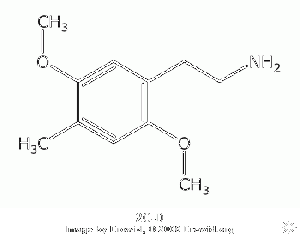2C-D: Difference between revisions
GrimReaper (talk | contribs) No edit summary |
(Added tables.) |
||
| Line 10: | Line 10: | ||
== Dosage == | == Dosage == | ||
{| class="wikitable" | |||
|+ Oral | |||
|- | |||
| Threshold || 3-4 mg | |||
|- | |||
| Light || 5-15mg | |||
|- | |||
| Common || 20-50mg | |||
|- | |||
| Strong || 50-100mg | |||
|} | |||
== Duration == | == Duration == | ||
{| class="wikitable" | |||
|+ Oral | |||
|- | |||
| Onset ||15-45 minutes. | |||
|- | |||
| Total || 3-5 hours. | |||
|} | |||
== Effects == | == Effects == | ||
Revision as of 09:36, 18 June 2016

2C-D is a short acting psychedelic drug of the 2C-X family. The effects of 2C-D are usually compared to 2C-B (although not as visual as 2C-B) or other psychedelic stimulants and sometimes to MDMA (ecstasy). Its effects are generally considered milder than 2C-B, LSD, or MDMA. 2C-D is also known for the strong body component of its effects which are alternately described as pleasurable energy or a 'sense of being in the body', and by others as an unpleasant 'buzzing' or body-load, which is mostly occurring during onset. Shulgin himself referred to this substance as a “pharmacological tofu,” meaning that when mixed with other substances, it can extend or potentiate their effects without coloring the experience too much, in a manner similar to how tofu absorbs the flavors of sauces or spices it is cooked with. Some people have claimed 2C-D is relatively uninteresting on its own, but many other users have strongly disagreed with this assessment and believe instead 2C-D to be a true psychedelic in its own right.
History
It was first synthesized in 1970 by a team from the Texas Research Institute of Mental Sciences, and its activity was subsequently investigated in humans by Alexander Shulgin.
Dosage
| Threshold | 3-4 mg |
| Light | 5-15mg |
| Common | 20-50mg |
| Strong | 50-100mg |
Duration
| Onset | 15-45 minutes. |
| Total | 3-5 hours. |
Effects
Positive
- Euphoria
- Giggling
- Empathy
- Personal Insight
- Enhanced Colors
- Closed and Open Eye Visuals
- Enhanced Tactile Sensation
- Spontaneity
Neutral
- Decreased Appetite
- Pupil Dilation
- Time Dilation
- Mild elevation in heart rate
Negative
- Restlessness
- Sweating/Chills
- Nausea
- Insomnia
- Muscle Tension
- Confusion
- Motor impairment
- Anxiety
Chemistry and Pharmacology
- IUPAC: 1-(2,5-Dimethoxy-4-Methylphenyl)-2-aminoethane
- Other names: 2,5-Dimethoxy-4-methyl-phenthylamine
- CAS# 25505-65-1
Harm Reduction
2C-D is one of the safer psychedelics, with several reported cases of users far exceeding commonly used dosing limits without lasting adverse physical effects. It is also observed to have a low addiction potential. It is a stimulating psychedelic, and therefore it's important to remain hydrated. Refer to Psychedelic Harm Reduction for more information.
Legal Status
- Denmark: 2C-D is added to the list of Schedule B controlled substances.
- Sweden: Sveriges riksdags health ministry Statens folkhälsoinstitut classified 2C-D as "health hazard" under the act Lagen om förbud mot vissa hälsofarliga varor (translated Act on the Prohibition of Certain Goods Dangerous to Health) as of March 1, 2005, in their regulation SFS 2005:26 listed as 2,5-dimetoxi-4-metylfenetylamin (2C-D), making it illegal to sell or possess.
- United States: Schedule I (Illegal to produce, supply, or possess)